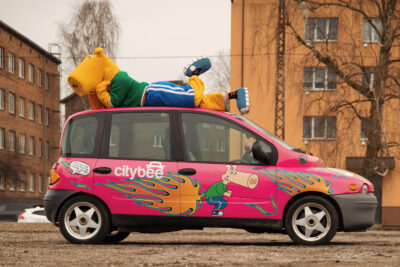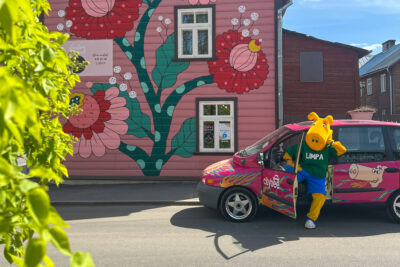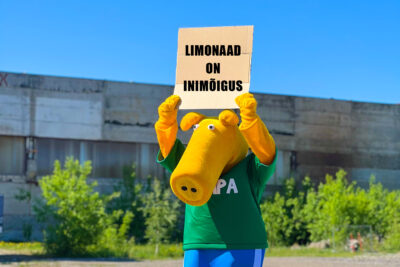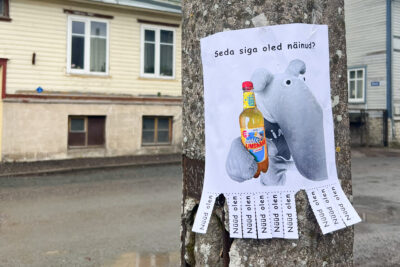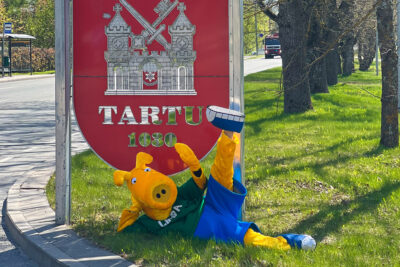
The Legend of Lemonade
Hey, babes!
I am Estonia’s most famous pig – Limpa. Basically, you could call me an icon.
The whole country drinks my lemonade, and my face is even recognized beyond the border, in Latvia.
If you ask me about my personal pronouns, I would say he/him. If you ask whether I’m a Millennial or Gen Z, let’s just say I’m technically Gen Z, but I identify as a Millennial. I’m quite easy-going by nature – I crack jokes and let out farts wherever it happens. However, if, for example, the president or some fancy folks are around, I can be very well-behaved too.
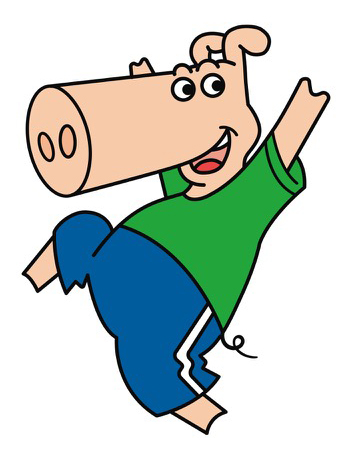
I generally get along with everyone – little kids who have just learned to walk, grandmas who buy Limpa for their grandchildren when they dare to visit once a year, and tbh everyone else falling between those two categories.
Over the decades, I have appeared in many TV commercials, entertaining both the young and old. If you find someone in Estonia aged 25-40 who doesn’t know the existence of Tšiki & Briki or Hull Õun, please show them to me, and I’ll introduce them to the Limpa lifestyle.
What is the Limpa lifestyle, you ask?
To live the Limpa lifestyle, you must be familiar with all things connected to Limpa:
- you must have drunk reasonable amounts of Limpa lemonade throughout your life;
- you must have read the book “Limpa and the Pirates” by Estonia’s best writer, Andrus Kivirähk;
- you must have participated in the Limpa children’s races at the Tartu or Tallinn Marathons or completed ski training at the Limpa ski school;
- you must have washed yourself at least once with Limpa shampoo;
- you must know at least one person who once had a flip-phone with Limpa branding;
- you must know at least one person who once had a Limpa-themed bank card;
- you must have slept between Limpa bed sheets at least once;
- you must have had Limpa children’s champagne at a birthday party;
- you must have spilled Limpa juice on yourself;
- you must have played Limpa board games;
- you must know all Limpa songs by heart, starting with “Tšiki-Briki” and ending with the song “Purk on lahe” (The Can is Cool);
- you must be aware that Limpa has a pink car that can be rented through the CityBee app.
If all the above points apply to you, then you can proudly declare yourself a true Limpa fan. I have quite a lot of fans like that in Estonia. I can’t walk peacefully in public without someone running up to hug me. Fans slide into my DMs, invade my door and car windows, and even throw themselves at me. Songs have been written and movies have been made about me. One fan even tattooed my name inside their lower lip. Now, that will stay with me for a lifetime!
I guess I don’t have much else to say. Keep drinking Limpa and follow me on Insta, okay? http://instagram.com/insta_limpa
Cheers!
Limpa
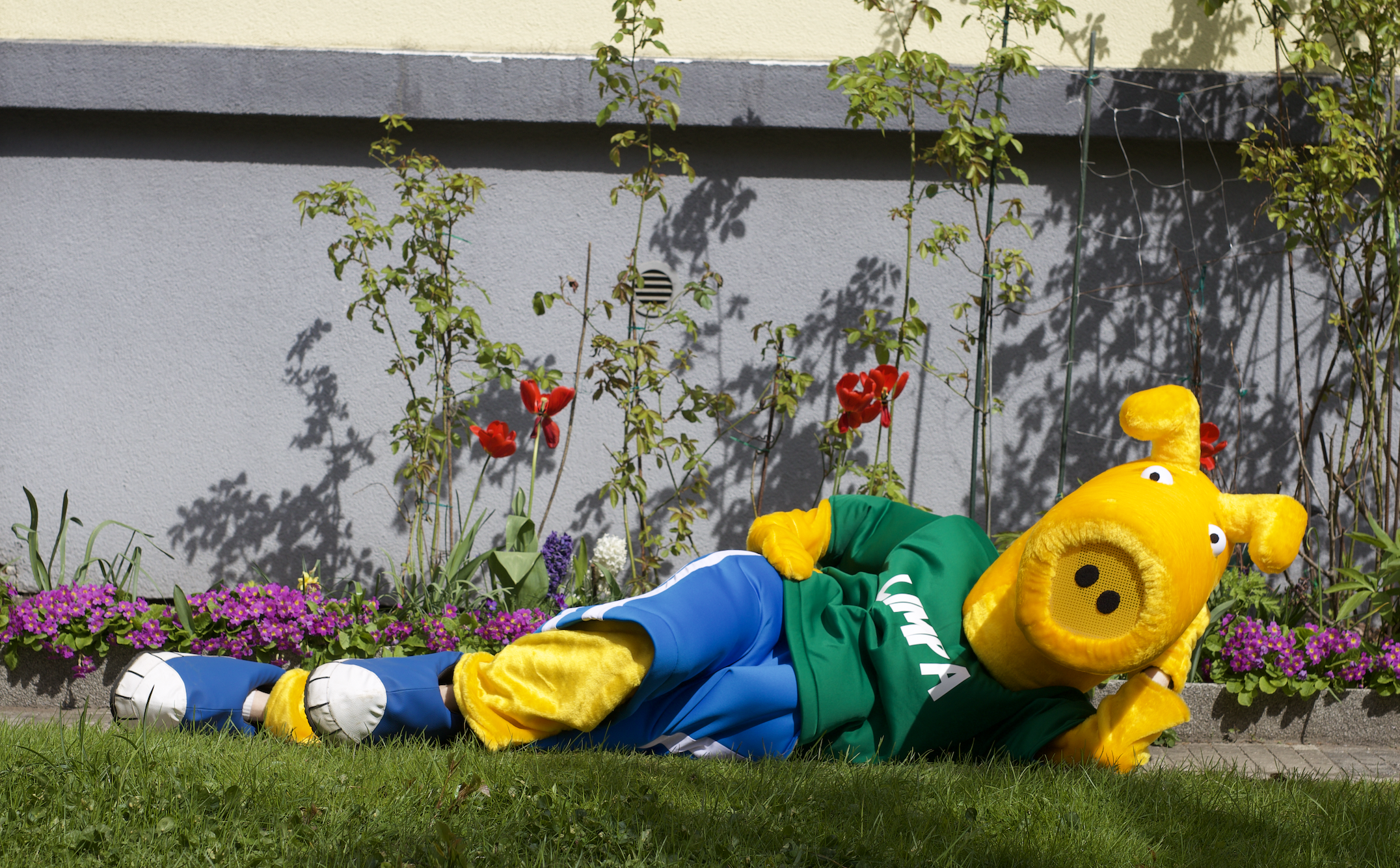
History of Soft Drinks
The history of the delicious lemon-flavored carbonated beverage, limonata, dates back to the 1630s in Italy. The oldest surviving instructions for making lemonade date back to the early 18th century. One recipe suggests soaking lemon peels in water, then adding lemon juice and coriander or cinnamon powder for flavor. Another recipe calls for boiling slices of lemon in spring water, adding sugar, and then cooling the drink. Both recipes recommended filtering the lemonade before consumption.
Surprisingly, the history of Estonian lemonade began in a pharmacy. The first records of a predecessor to lemonade date back to 1634 when Gerhard Himsel, the town physician of Tallinn, started producing a novel lemon beverage in Estonia, which was offered in the pharmacy as a quasi-universal medicine. A couple of hundred years later, in 1860, a pharmacist named Schoeler in Viljandi began selling carbonated fruit drinks outside the medical field, marking the beginning of wider lemonade production.
In 1899, the predecessor of the present-day A. Le Coq company, AS Tivoli, established a lemonade department, marking the first industrial production of carbonated beverages in Estonia. Unfortunately, the methods used to make those early lemonades, their shelf life, and their taste are not known. However, it can be assumed that inspiration and guidance were obtained from the lemonade workshops in pharmacies, some of which remained operational until the late 1930s.
In the years following World War I, A. Le Coq did not produce carbonated beverages. This was influenced by the destructive activities of the German occupation forces, who, among other things, destroyed the equipment necessary for lemonade production in 1918. It was not until 1925 that the carbonated beverage department was restored when new equipment was brought from the Tallinn Lemonade Factory, Talko. Four years later, these were replaced by state-of-the-art equipment, and in addition to lemonade, they produced orange, rhubarb, and pineapple lemonades, lemon soda, seltzer, and mead.
Competition in the soft drink industry was fierce, and by 1933, the number of companies producing lemonade in Estonia had grown to 170. A significant change in the soft drink industry occurred in 1935 when a new law permitted the use of acids and synthetic extracts only in the production of seltzer and other artificial lemon waters and sodas. All other varieties had to be made exclusively from natural juices. Limits were also set for juice content, sugar, and carbonation. The control over raw materials led to the introduction of a quality mark for the first time in Estonia.
A breakthrough in the quality and taste of lemonade occurred in 1946 when A. Le Coq (then known as Tartu Brewery) started producing traditional lemonade according to the recipe developed by Mitrofan Lagidze, a technician at the Tbilisi Lemonade Factory, in 1936. Hence, the label of the traditional lemonade still produced today bears the inscription “Refreshing lemonade made according to the original recipe from 1936.”
In addition to A. Le Coq (formerly Tartu Brewery, later Tartu Experimental Brewery), lemonades were also produced in other Estonian breweries. The largest lemonade manufacturer in Tallinn was the Tallinn Carbonated Drinks Experimental Factory. Lemonade was produced in the Pärnu Brewery, and for a short time, lemonade and fruit juices were also made in the Saku Brewery. During the Soviet period, carbonated beverages and lemonade were also produced by the bakery industry cooperatives of the ETKVL, with the Võru Bread Combine’s lemonade factory being the most significant. In the early 20th century, besides lemonade, beer was also brewed there, but later the former brewery focused solely on bread and carbonated beverage production.
In the mid-1960s, soft drinks began to be bottled in 0.33-liter bottles. During the same decade, new recipes were developed in Tartu. Automated machines for carbonated drinks were installed in cities, which, in turn, reduced the demand for bottled drinks. In 1965, a colorless carbonated drink called Kelluke was created in our factory, which became very popular at that time and remains so to this day. In the same year, a grape juice-based drink called Punamütsike was also introduced. In 1970, Kelluke, Punamütsike, and Õun became the first carbonated drinks in the USSR to receive the quality mark. In the same year, the first domestic alcohol-based diluent, Toonik, was developed. Two years later, Estonia’s first sports drink, Sportlane, was created, and in collaboration with specialists from the Tartu State University Faculty of Physical Education, another sports drink, Maraton, was introduced in 1977.
The new era brought plastic bottles and the triumph of larger packaging. Therefore, since 1996, A. Le Coq (then still Tartu Brewery) has been bottling carbonated beverages in addition to glass bottles also in plastic bottles. Kelluke and Limonaad, which became symbols of Tartu’s lemonade masters, remained, but many new flavors were introduced. The year 2002 was significant when the lemonade pig Limpa came into action, experimenting with various flavors of sodas as well as juice products and sports drinks in its “limonatorium”.
Traditsiooniline Limonaad is still the most popular soft drink in Estonia. It is a bubbly mixture of water, caramel syrup, and a special flavor extract. The core flavor profile of this beloved drink includes apple, citrus fruits, herbal extracts, and vanillin.
The idea behind the birth of lemonade – to offer a drink with a distinctive taste that can be enjoyed by both adults and children – has persisted to this day. Lemonade is not intended to replace water, but when consumed in moderation alongside physical activity and a balanced diet, it has become a popular carbonated drink in our drink selection for almost a century!
Authentic Estonian Soft Drinks
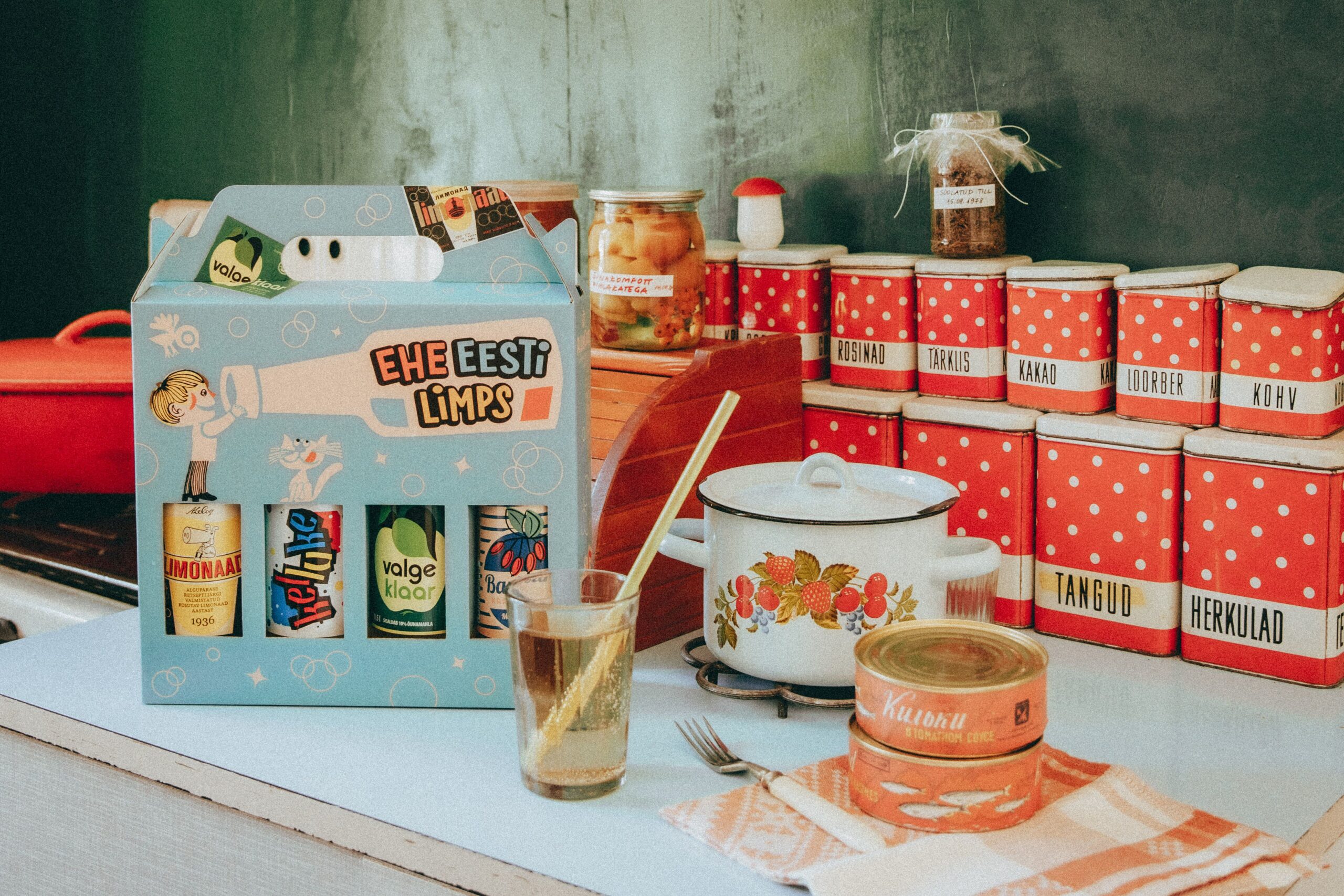
Who wouldn’t occasionally reminisce about carefree childhood days, the bright blue sky, and the greenest of green grass that would stain our knees by evening, making our parents shake their heads in disbelief? Authentic memories of a time when the world fit in the palms of our hands and then fluttered away like a butterfly, disappearing into the unknown. These memories are intertwined from generation to generation with real things that existed in our childhood and are still here today. Authentic, unique, and precisely the right flavor we remember – these are the authentic Estonian soft drinks: Limonaad, Kelluke, Valge Klaar, and Barbariss. Together, they carry over 200 years of bubbly memories and uncompromisingly good taste.
Limonaad
The star with the “Authentic Estonian Soft Drinks” label is the traditional and uniquely flavored carbonated drink Limonaad – the one and only. The recipe, created in 1936, has been continuously produced by A. Le Coq for almost 80 years. The composition of Limonaad includes a combination of unique extracts, and no other company has been able to replicate its distinct flavor. The genuine classic taste of Limonaad is known from generation to generation, connecting current grandparents, parents, and new fans of the soft drink. A significant contribution to introducing Limonaad has been made by Estonia’s own hero, the soft drink pig Limpa, whose greatest wish is for Limonaad to never run out.
Kelluke
Kelluke is the most classic citrus-flavored soft drink, and its taste can be described as the one and only true lemonade. The recipe for Kelluke was developed by A. Le Coq (then known as Tartu Brewery) in 1965, and it became the most widely produced lemonade throughout the Soviet Union. Thanks to the recipe developed by Estonians, this taste has been a favorite both in the Baltic States and in the Transcaucasian region. Sweet Kelluke carries the carefree taste of childhood!
Valge Klaar
Valge Klaar is a rediscovered old favorite. Based on the original recipe from 1976, this carbonated beverage contains 10% genuine apple juice and tastes just as good today as it did back then. Its pleasant nostalgic note brings a touch of the past to the modern everyday life, presenting the authentic taste of fresh apples with a stylish retro design. How many carbonated beverages sold in Estonia can proudly boast such a pure and genuine apple flavor? Valge Klaar can – it’s an authentic Estonian soft drink!
Barbariss
Barbariss is a soft drink filled with sweet memories that are different from the rest. Among the retro soft drinks carrying the “Authentic Estonian Soft Drink” label, Barbariss is the newest addition, evoking the incomparable taste of childhood barbaris candy. Did you know that the flavor of barbariss is actually the flavor of the buckthorn berry, and its name comes from the Latin name of the plant borrowed from the Russian language? With its nostalgic retro label, it brings a touch of the past to the modern everyday life, making it a great refreshment for those who reminisce about their childhood and for those who are still wandering along the paths of childhood.
At A. Le Coq, we stand for the development and preservation of Estonian beverage culture, ensuring that the distinctive flavors of our region are available for the enjoyment of future generations of soft drink enthusiasts. What would Estonian beverage culture be without authentic Estonian flavors?
Soft Drink Production
Soft drink production is pure joy in the process of creation. To make it more exciting, the lemonade pig Limpa has taken it upon itself to create a comprehensive diagram and show exactly when and how a million bubbles get into the Limonaad bottle.
The uniquely classic taste and delightfully effervescent nature of Limonaad always come with a smile. The precise composition of Limonaad is, of course, a secret, but as Limpa knows, it wouldn’t achieve its joyful flavor experience without the very special combination of extracts in Limonaad.
Experienced masters prepare the syrup and add both the Limonaad extract and caramel derived from caramelizing sugar, which gives Limonaad its characteristic brownish color. Then comes the moment when the magic of the syrup mixture merges with the sparkling water, creating a captivating effervescent drink.
Perfectly shaped bottles are blown in a hot oven, and then the bottling process begins, followed by the final touch of adding labels. In just one hour, a total of 18,000 bottles of Limonaad are produced!
If anything remains unclear, our esteemed partner, the AHHAA Science Center, offers the opportunity to participate in a Limonaad masterclass and create your own perfect, pleasantly effervescent Limonaad according to your taste, using our original ingredients. Workshops are held for center visitors on weekends and during school breaks. It is also possible to arrange visits to the Limonatorium for group tours.
Those who don’t move, don’t enjoy Limonaad
This is the modern proverb of our time. It’s true: to experience the joy of a carbonated beverage, one must move and pay attention to balanced nutrition.
A. Le Coq is an Estonian producer with a long tradition of making carbonated drinks. By offering authentic Estonian flavors, we aim to be more than just a beverage manufacturer. “Those who don’t move, don’t enjoy the Limonaad!” is a principle through which we support the physical activity of children and youth. We want Estonian society to be active, full of energy, and healthy!
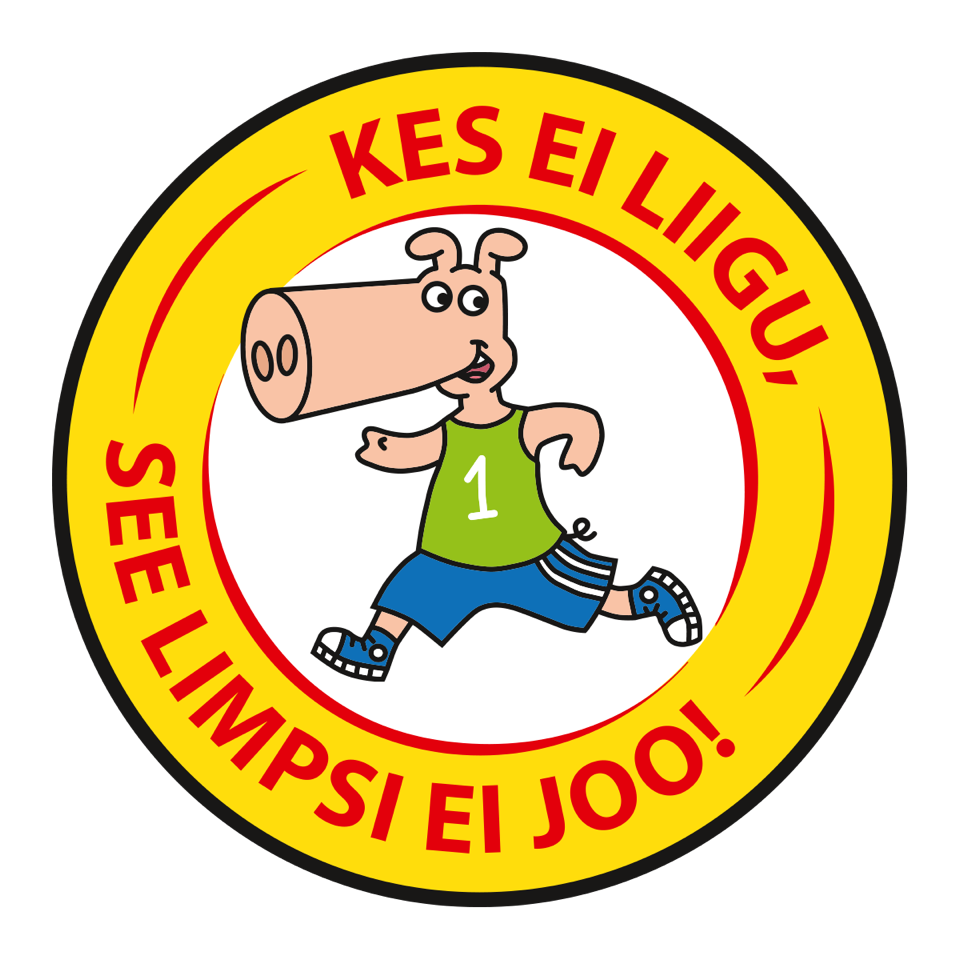
Limpa participates in the children’s events of Tartu Marathon, where children can experience the joy of sports through skiing, running, and cycling. Additionally, we support other sports events such as the Maijooks, Narva City Run, and the children’s races of the Tallinn Marathon. All brave participants of the children’s races receive a diploma, a medal, and a refreshing Limpa soft drink as a reward. Children also have the opportunity to attend Limpa Ski School to develop their skiing skills.
In addition to the traditional Limpa soft drink, we also offer Limpa sports water, equipped with a sports cap, perfect for quenching your thirst.
So, if you want to experience the joy of sports and enjoy Limpa drinks, there’s nothing else to do but move! A glass (200 ml) of Limpa drink will give you the energy and strength to skateboard for 13 minutes, jump rope for 9 minutes, ride a bike for 7 minutes, swim for 12 minutes, walk for 17 minutes, and ski for 11 minutes. Find your favorite sport and enjoy the pleasure of movement!

